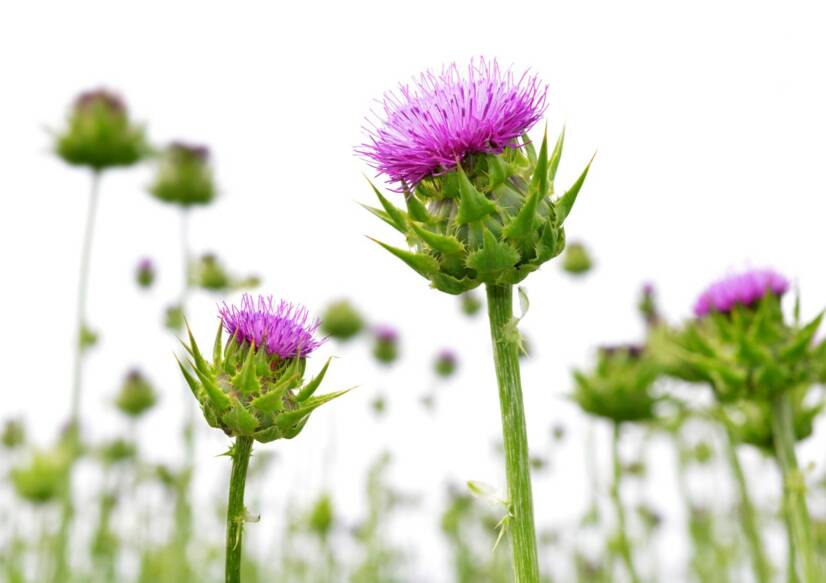- Herbarium or from alchemilla to jindava (Jaroslava Bednářová ) - characteristics and occurrence of milk thistle
- Herbarium or nature in your kitchen (Jaroslava Bednářová ) - collection, folk medicine of milk thistle
- vasbylinkar.sk - how to use milk thistle, characteristics, collection
- chovatelahospodar.sk - growing milk thistle
Milk thistle: Effects on the liver, health? How to use and grow it?

Milk thistle, also called St. Mary's thistle, has had a prominent place in households in the past. This plant was eaten as a vegetable (with oil and table salt), and its root was used with mead as a poultice. The ancient Romans used it most often for diseases of the liver, gallbladder and spleen.
Characteristics
Milk thistle is used for its positive effects on health. What are its effects on the liver? How to use and grow it properly? We will answer these and other questions in our article.
Milk thistle, Latin Silybum marianum, is an annual to biennial, stout, thistle-like plant in the Asteraceae family.
It can reach a height of 150 cm and sometimes up to 250 cm.
The plant is spiderweb-like and hairy.
The leaves at the base are petiolate and about 40 cm long. The leaves of the rhizomes, on the other hand, are slightly smaller and sessile.
All leaves of the thistle are hollow and sharply toothed, bright, glossy, stiff and often with white spots on the cheek.
The flowers of milk thistle are red to purple in colour.
The plant flowers from July to September.
Its fruits are achenes with a stalk.
Occurrence of milk thistle
The Canary Islands, the Mediterranean, Asia Minor and Antarctica are considered to be the original range.
It may also occur on other continents because it has been introduced.
It is commonly found as a plant grown in gardens or growing wild in thickets, along roadsides, in compost heaps and on stony hillsides.
How to identify thistles in nature
Milk thistle gets its name from the milky white stripes visible on its leaves.
According to legend, these stripes come from the milk of the Virgin Mary.
The plant has an unusual appearance and is therefore often grown as an ornamental garden herb.
It can often be confused with other thistles in the wild, such as curly thistle, common thistle or greater burdock.
Internal use
In the past, the leaves and root were used. Today, mainly the aerial parts are used.
The seeds are most often sought after for their beneficial effects.
The fruits (seeds) of milk thistle contain:
- sulphur-containing amino acids
- proteins
- magnesium
- saturated fatty acids (linoleic acid, oleic acid)
- vitamin E
The flavolignans, silybin, silydianin and silychristin, collectively called silymarin, are responsible for their positive effects.
Silymarin is considered a very powerful antioxidant.
Consumption of crushed seeds of milk thistle berries is most effective because it contains the active substances flavolignans.
Silymarin is formed continuously in milk thistle, especially in September or October.
The ideal temperature is around 25℃.
Healthy liver and gallbladder
Because milk thistle is a very strong antioxidant, it supports the human immune system.
It cleanses the liver, regenerates the liver parenchyma, improves the production and distribution of bile and has a positive effect on blood sugar and cholesterol levels.
In addition, it affects the heart and digestive system.
Milk thistle and jaundice, cirrhosis, steatosis
Milk thistle is used in liver and gallbladder diseases , but also in the following diseases:
- Hepatitis B and C.
- cirrhosis of the liver
- steatosis of the liver
- mononucleosis
- diseases of the spleen
- gallstones
- intoxication with alcohol, drugs or mushrooms
- liver damage due to long-term use of drugs
Silymarin, which is contained in the fruit, accelerates the regeneration of liver tissue. This is useful in the long-term use of drugs.
In addition, it increases the chances of recovery and survival in case of poisoning (intoxication) by toadstool.
It is a powerful antioxidant. These are the beneficial effects of milk thistle in a nutshell:
- regenerates cells
- harmonises digestion
- has a beneficial effect on the liver
- restores the liver membrane
- contains silymarin
- has a positive effect on the gallbladder
- reduces the risk of tumours
- lowers LDL cholesterol
- helps with liver disease
- helps with migraines
- strengthens the immune system
- scavenges free radicals
- helps with mononucleosis
- protects against DNA damage or alcohol and fungal poisoning
External use
Its effects will certainly be appreciated by people suffering from hemorrhoids and varicose veins.
A decoction of the root or twigs (leaves) of milk thistle is excellent for tibial ulcers.
For skin diseases, powder from the root or leaves is used.
Harvesting and storage
The seeds are the basis of the harvest, the roots and leaves are rarely harvested.
At the end of summer, before the plant is fully ripe, cut the whole plant and leave it to ripen in the air.
Thistle seeds are threshed and cleaned of hairs.
The seeds need to be scrubbed to extract the active substances.
The finely crushed thistle fruit oxidises quickly, thus devaluing its active ingredient silymarin.
It should therefore be stored in a container without air.
Cultivation
Since milk thistle is native to the Mediterranean, air temperature plays an important role in cultivation.
Seeds are usually used for sowing.
If we are lucky enough to have a warm spring, thistles can be planted directly into the soil in the garden as early as March.
Thistles start flowering in June.
It is an arid-loving plant that loves the sun.
It thrives best in sandy soil, but in practice it has been shown that you can grow it in any soil (loam, clay, acid).
It prefers direct sun but can also grow in partial shade or shade.
Ideally, thistles should be watered every other day.
If the plant wilts, it will recover quickly after watering.
What is the best way to consume milk thistle?
The crushed seeds of the berries are considered the most effective.
At the same time, perfect absorption of its active substances is ensured.
This brings the advantage of cleaning the intestinal walls, which helps to cleanse the digestive system.
We consider effective the use of crushed seeds that have not come into contact with metal during crushing and have not been exposed to temperatures higher than 40℃.
Folk medicine
Milk thistle fruits are excellent in fighting liver diseases.
Taking the powder, which is made from the crushed berries, or drinking the decoction helps to regenerate the liver quickly and affects the production of bile.
It has a beneficial effect on metabolism.
The plant helps with low blood pressure, tonifies blood vessels, corrects circulatory disorders and relieves migraines and dizziness.
It is also recommended for asthma attacks and eliminating travel sickness.
Its use is of great importance in the treatment of fatty liver, convalescence, cancer and also after chemotherapy, against fatigue, etc.
Nutritional values of crushed milk thistle berries
| Energy value | 1549 KJ |
| Protein | 20 g |
| Carbohydrates | 7 g |
| Fats | 21 g |
| Fibre | 38 g |
Usage
Thistle berries can be made into a tea.
To leach out the active substances in the tea, the fruits must be crushed.
It is best to consume the berries cold, as hot water or boiling will destroy much of the active ingredient.
Another consumption option is to add the crushed seeds to yogurt or juice.
Interesting resources










